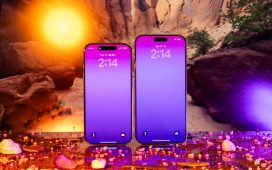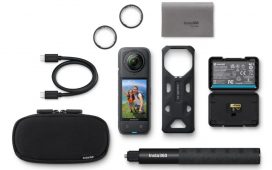The MagSafe Battery Pack debuted in 2020 alongside iPhone 12.
One of my earliest stories to grace this column was about Apple’s Smart Battery Case for what then was the company’s flagship iPhone 11 and 11 Pro Max phones. In my piece, I praised the accessory on multiple levels. From an accessibility perspective, not only did the Smart Battery Case obviously provided extra juice for someone whose low vision absolutely requires maximum brightness at all times—much to the chagrin of my iPhone’s Battery Health panel, Auto Brightness is forever disabled—the case itself provided ample friction such that my hands could better grip my phone. Although in hindsight the Smart Battery Case was big and bulbous and belying of its precision-crafted industrial design, the reality is it made using the iPhone an appreciably more accessible experience.
Suffice it to say, I was sad when Apple discontinued it.
It didn’t take long for me to warm up to the Smart Battery Case’s replacement in the now-discontinued MagSafe Battery Pack. Introduced in 2020 with the iPhone 12 series and the advent of MagSafe charging, the MagSafe Battery Pack is not at all a case. As the name implies, it’s a white, square-shaped that’s decidedly more backpack in nature compared to its predecessor’s jacket form. As an official MagSafe accessory, simply put the Battery Pack on the phone and it connects. Apple’s documentation still reports the MagSafe Battery Pack being compatible with iPhones up to the iPhone 14 series; I can confirm, however, the last few versions of iOS support it with aplomb, as I’ve used it heavily on both last year’s iPhone 15 models and this year’s iPhone 16. The one downgrade from the Smart Battery Case to the MagSafe Battery Pack is the former’s integrated shutter button. That functionality, an exemplar of Tim Cook’s “Only Apple” boisterousness of controlling both stacks, hardware and software, of course has been reincarnated and reimagined as a headliner feature of iPhone 16. Conceptually, however, it bears repeating that the Camera Control button on the new iPhones lineage directly traces back to the Smart Battery Case’s shutter button.
Apple curiously didn’t upgrade the MagSafe Battery Pack to USB-C when the iPhone 15 switched from Lightning last year. When or if the company will do so, nobody knows. As a practical matter, I’ve had no problems whatsoever occasionally “changing modes” from USB-C to Lightning (and vice-versa) in the few years I’ve had the MagSafe Battery Pack. I keep a USB-C-to-Lightning cable permanently attached to the iMac on my desk for charging the Pack, as well as my well-worn Lightning-powered AirPods Pro 2. Likewise, I keep another USB-C-to-Lightning cable in my travel kit for the exact same purpose. Although there’s a cogent argument to be made that One Cable To Charge Them All, it being USB-C, for cognitive reasons, the broader tech community is myopic in that viewpoint. The reality is, 99.9% of the tech commentariat—many of whom are close friends of mine!—are privileged insofar as they can achieve Cable Oneness because they can use cables. In a sentence, it’s a motor skills issue. Having USB-C everywhere is convenient so long as you have good hand-eye coordination to boot.
As someone with multiple disabilities that profoundly impact my hand-eye coordination, having USB-C on my cacophony of devices is beneficial only so far. Fatalistic though it sounds, my mindset is having a single connector type for all my devices is a wash because, whether USB-C or Lightning, I know I’m going to struggle plugging and unplugging the cable. If I’m going to struggle mechanically, I’m not about to add insult to injury by going all-in on USB-C out of adherence to tech nerd dogma.
Like ProMotion and high refresh rate displays, I’m not at all against technological progress. What I’m against is this table stakes mentality of mainstream tech reviewers and wannabe MKBHD tech YouTubers who say Lightning is old and decrepit and USB-C is the future. USB-C is definitely in, but true innovation isn’t swapping one inaccessible connector for another. Standardization notwithstanding, true innovation would be Apple slathering its secret sauce onto USB-C to somehow make it like MagSafe. That would prompt me to upgrade to a theoretical MagSafe Battery Pack in a nanosecond. What’s more, because I prefer the company’s ecosystem, I couldn’t care less if Apple restricted said technology to its own kit. What I do care about is access that enables me to easily charge via physical cable—which is predictably left out of any conversation surrounding USB-C. It’s exasperatingly frustrating.
Charger arcana aside, what makes the dearly-departed MagSafe Battery Pack such a beloved tool is, again, how it accentuates the iPhone experience for me. The power gains are obvious, but I also am deeply appreciative of how I can see the Battery Pack’s charge level from the Batteries widget on my iPhone. I appreciate the system informing me the Battery Pack will charge iPhone to 90% full. These are ostensibly implementation details that helps me reduce cognitive load by helping me with power management, all the while the physical object is immensely easy to affix and remove by virtue of magnets. I have a bunch of Apple Pencils and AirPods. I use Apple’s silicone cases. I know the company’s accessory game. Without hesitation, the MagSafe Battery Pack (with Lightning!) remains my most favorite Apple accessory of all time—despite its perceived obsolescence because it uses Lightning.
This thing is fast becoming a close second. As to the MagSafe Battery Pack, absent a new one with USB-C, I can’t recommend it highly enough.










